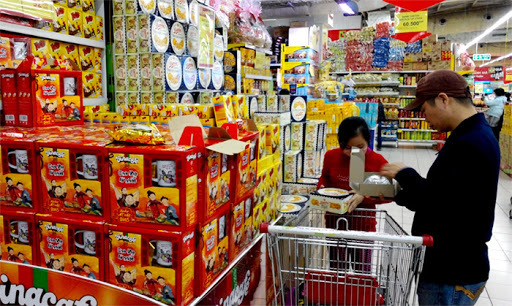According to General Statistics Office, the revenue in Q1 of the food and beverage, hotel and tourism services decreased by 9.6 percent and 27.8 percent, respectively.

CBRE Vietnam reported that the number of visitors to shopping centers decreased by 80 percent in Hanoi and HCM City during the epidemic. While the revenue from offline sales dropped sharply, e-commerce and online shopping ‘saved’ retailers.
Tiki reported 4,000 orders per minute. SpeedL and Saigon Co-op also reported exponential growth rate in online sales. Grab, an e-hailing app, kicked off GrabMart service to satisfy the shopping needs of people who had to stay home to avoid gatherings.
| Tiki reported 4,000 orders per minute. SpeedL and Saigon Co-op also reported exponential growth rate in online sales. Grab, an e-hailing app, kicked off GrabMart service to satisfy the shopping needs of people who had to stay home to avoid gatherings. |
CBRE reported that in Asia Pacific, omni-channel and online retail have been doing very well during the epidemic, from consumer goods and cosmetics to luxurious products such as cars. In the long term, the development of e-commerce will serve as the firm foundation for the retail market.
Vo Thi Phuong Mai from CBRE Vietnam commented that Covid-19 had a negative impact on number of visitors to physical shopping centers, but created many opportunities for small and medium retail models such as convenience stores and e-commerce.
Offline sales
Vietnam is listed by AT Kearney among the most bustling markets. The high economic growth rates, population of 100 million with high proportion of young people who have increasingly high incomes, and rapid urbanization which creates new shopping and consumer trends all explain the attractiveness of the market.
However, the epidemic has led to the changes in consumers’ shopping behaviors. This has forced retailers to change their business strategies to adapt to the new circumstances.
Saigon Co-op, a traditional retailer established in 1996, has shifted to omni-channel sales when selling goods via TV, applying Scan & Go and cooperating with MoMo e-wallet.
A recent survey by Nielsen found that Vietnam ranks third among 11 countries and territories where the trend of cooking at home is growing, with 62 percent of polled people confirming the new habit. The other two include China (86 percent) and Hong Kong (77 percent).
The statistics could be a suggestion for retailers to change their business strategies to adapt to the new circumstances. Retailers can boost sales through online channels, take full advantage of different delivery channels and develop O2O (offline to online) services and promote multi-channel integration.
“We understand that we have to take full advantage of the ‘wind power’ from Covid-19 to accelerate the digital transformation process that we began in late 2017,” said Le Tri Thong, CEO of PNJ jewelry retail chain.
Chi Mai

From retail to finance, Vietnam all set to rebound with poise
Vietnam’s early efforts to weather the COVID-19 storm have helped its economy to reopen much sooner than others, with many sectors that have suffered badly from the outbreak – from retail to finance –now recovering with poise.

E-commerce a positive for retail sector
Despite the impact of the COVID-19 pandemic, the retail market in Vietnam in the first quarter of this year still recorded positive results from e-commerce, online shopping and delivery services.
 Despite the epidemic, the Vietnamese retail market in Q1 saw positive signs from e-commerce, online shopping, and delivery services.
Despite the epidemic, the Vietnamese retail market in Q1 saw positive signs from e-commerce, online shopping, and delivery services.